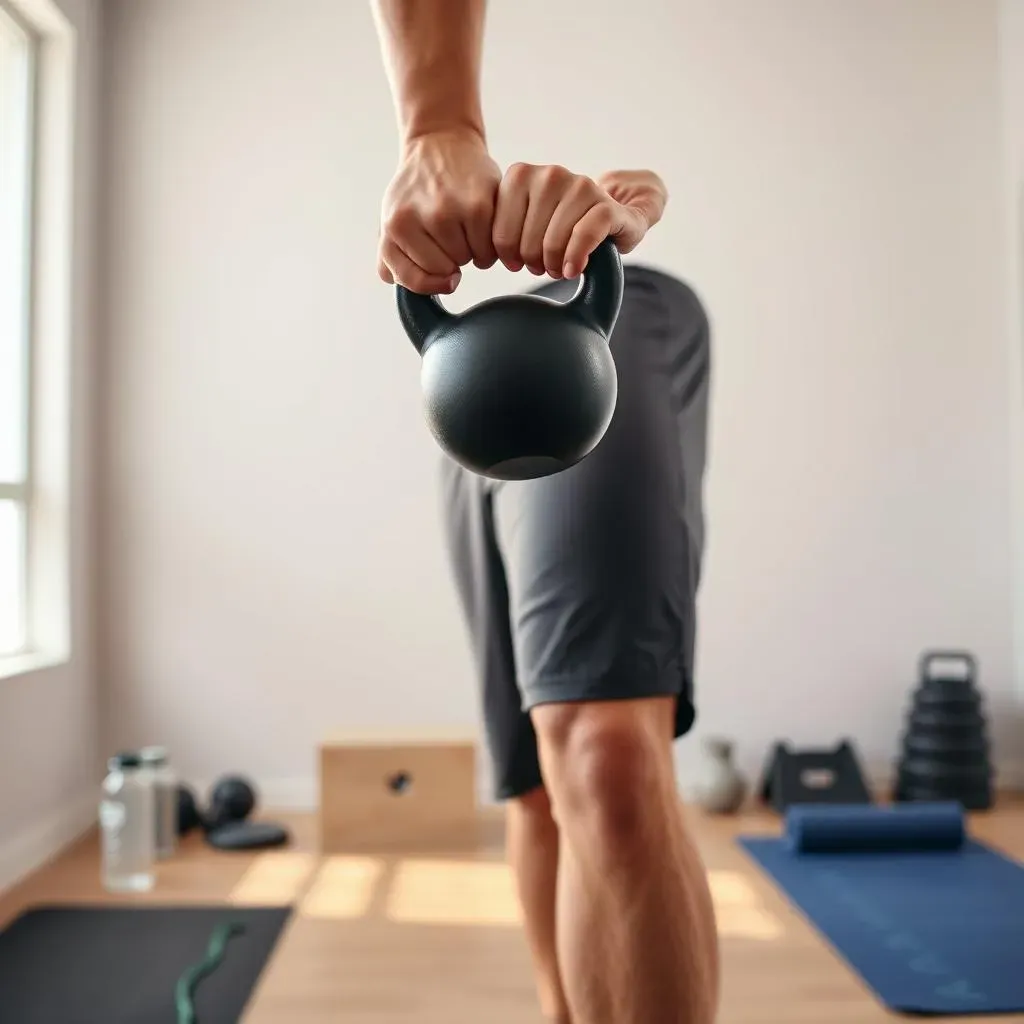Table of Contents
Short on time but big on fitness goals? Then you've come to the right place! This article is your guide to a killer 15-minute beginner kettlebell workout. Forget those hour-long gym sessions – we're showing you how to maximize your results in a fraction of the time. We'll walk you through choosing the right kettlebell for your strength level, setting up your workout space, and mastering three simple yet highly effective exercises. This isn't just another quick fix; it's a foundational workout that builds strength, endurance, and coordination. Get ready to discover the power of kettlebells and how a short, focused routine can make a huge difference in your fitness journey. By the end of this 15-minute beginner kettlebell workout guide, you'll have a go-to routine that fits seamlessly into even the busiest schedule. So grab your kettlebell, and let's get started! We'll cover choosing the right kettlebell weight, setting up your workout space, and the three core exercises that form the basis of this effective routine. We'll also offer tips to help you progress and stay motivated, transforming this 15-minute workout into a habit you'll love.
Getting Started: Choosing Your Kettlebell and Setting Up

Getting Started: Choosing Your Kettlebell and Setting Up
Finding the Right Kettlebell Weight
Picking the perfect kettlebell is key! Start with a lighter weight, especially if you're new to kettlebell workouts. Think of it like this: you wouldn't run a marathon on your first day of jogging, right? A lighter weight allows you to focus on proper form and technique without getting overly fatigued. You can always increase the weight as you get stronger. A good starting point for many beginners is an 8kg (18lb) kettlebell for women and a 12kg (26lb) for men, but always listen to your body!
Don't worry about looking "weak" by choosing a lighter weight. Mastering the moves is far more important than lifting heavy. Plus, you'll see amazing results even with a lighter kettlebell. Remember, consistency is key! Check out our guide on beginner kettlebell workouts for more tips.
- Start light and focus on form.
- Gradually increase weight as you get stronger.
- Listen to your body and don't push yourself too hard.
Setting Up Your Workout Space
You don't need a fancy gym to do this workout! All you need is a space about 6 feet by 6 feet where you can move freely. Make sure the floor is clear of obstacles – you don't want to trip over anything mid-swing! A mat or rug can make the floor more comfortable on your knees and joints. If you're working out outside, choose a level surface.
Good lighting and ventilation are also important. You want to be able to see what you’re doing and avoid overheating. Make sure you have enough space around you to move freely and avoid hitting anything. Once you've found your space, you’re ready to start! This 15-minute workout is perfect for a quick, effective session, but if you want a longer workout, try our 20-minute kettlebell workout.
Requirement | Description |
|---|---|
Space | 6ft x 6ft clear area |
Surface | Level and clear |
Mat (Optional) | For comfort |
Getting Ready: Warm-up and Safety
Before you start swinging that kettlebell, a quick warm-up is essential to prepare your muscles and prevent injury. Five minutes of light cardio, like jumping jacks or high knees, followed by some dynamic stretches, such as arm circles and leg swings, will get your blood flowing and your body ready for action. Don't skip this step!
Safety first! Remember to maintain good posture throughout the workout, engaging your core muscles to stabilize your body. If you feel any pain, stop immediately and don't push through it. If you’re unsure about any of the exercises, watch some videos online or consult a fitness professional. Remember to check out our beginner kettlebell program for a more detailed plan.
The Workout: Three Simple Exercises for Maximum Impact

The Workout: Three Simple Exercises for Maximum Impact
Kettlebell Swings: The Foundation
We're starting with the king of kettlebell exercises: the swing. It's deceptively simple, but it works wonders for your entire body, building strength in your legs, glutes, back, and shoulders. Imagine it like this: you're mimicking the motion of chopping wood, but with a kettlebell. The power comes from your hips, not your arms. Keep your back straight, hinge at the hips, and swing the kettlebell between your legs and up to chest height. Focus on controlled movements; don't just fling it around! Aim for 10-12 repetitions. Need a visual guide? Check out our beginner kettlebell exercises PDF for detailed instructions.
Remember, proper form is crucial here. If you're struggling, start with a lighter kettlebell and focus on getting the technique right. You'll feel the burn in your glutes and hamstrings - that's a good thing! Don't worry if you don't feel it immediately - consistency is key. For a more comprehensive guide, check out our beginner kettlebell workout guide.
- Hinge at the hips, not the waist.
- Power comes from your legs and hips.
- Keep your back straight.
- Swing to chest height.
Goblet Squats: Building Lower Body Strength
Next up: goblet squats. Hold your kettlebell close to your chest, like you're holding a goblet (hence the name!). Then, squat down as if you're sitting in a chair, keeping your back straight and your chest up. The kettlebell helps you maintain balance and adds resistance. Aim for 10-12 repetitions. This exercise is amazing for building strength in your quads, glutes, and hamstrings.
Imagine you're trying to sit down on a really small chair. That's the depth you're aiming for. Don't let your knees cave inwards – keep them aligned with your ankles. If you find it challenging to maintain balance, try a lighter kettlebell or use a chair for support initially. For more lower-body focused routines, check out our kettlebell workouts for women.
Exercise | Reps | Sets |
|---|---|---|
Kettlebell Swings | 10-12 | 2 |
Goblet Squats | 10-12 | 2 |
Kettlebell Rows | 10-12 (each side) | 2 |
Kettlebell Rows: Targeting Your Back
Finally, we'll work on your back with kettlebell rows. Hold the kettlebell in one hand, letting it hang down. Hinge at your hips, keeping your back straight. Pull the kettlebell towards your chest, squeezing your shoulder blades together. Lower it slowly back down and repeat. This exercise strengthens your back muscles, improves posture, and helps prevent back pain. Aim for 10-12 repetitions on each side. Remember to keep your core engaged throughout the exercise.
This is a great exercise for improving your posture and strengthening your back muscles. Don't be afraid to start with a lighter weight if you're new to this exercise. Focus on controlled movements and feel the burn in your back muscles. If you're looking for a more targeted back workout, check out our kettlebell arm workout guide which also incorporates back exercises.
Beyond the 15 Minutes: Tips for Progress and Staying Motivated

Beyond the 15 Minutes: Tips for Progress and Staying Motivated
Consistency is Key
The magic of kettlebell training, and fitness in general, isn't about intense, infrequent workouts. It's about consistent effort. Aim to do this 15-minute workout at least three times a week. Think of it as a daily vitamin for your body – small, regular doses lead to big, long-term results. Don't get discouraged if you miss a day or two; just jump back in when you can. The key is to make it a habit, not a chore.
Remember, even small amounts of exercise are better than none. If you find it tough to fit in three 15-minute sessions, try breaking it up into shorter bursts throughout the day. Five minutes here, five minutes there – it all adds up! For more ideas on shorter workouts, check out our 10-minute kettlebell workout guide.
- Consistency is more important than intensity.
- Aim for at least three 15-minute sessions per week.
- Don't be afraid to break it up into shorter sessions.
Listen to Your Body (and Gradually Increase the Challenge)
Your body is your best guide. Pay attention to how you feel during and after your workouts. If you're feeling sore, that's normal, especially when you're starting. But if you're experiencing sharp pain, stop immediately. Rest and recovery are just as important as the workout itself. As you get stronger, you can gradually increase the weight of your kettlebell, the number of repetitions, or the number of sets. Don't rush this process – slow and steady wins the race!
Think of your fitness journey as climbing a mountain – one step at a time. Celebrate your small victories along the way. Did you manage to do an extra repetition? Fantastic! Did you maintain perfect form throughout the workout? Amazing! These small wins will keep you motivated and help you build momentum. Want a more structured approach? Check out our beginner kettlebell program for a detailed plan.
Week | Weight (kg) | Reps | Sets |
|---|---|---|---|
1 | 8 (women)/12 (men) | 10 | 2 |
2 | 8 (women)/12 (men) | 12 | 2 |
3 | 10 (women)/14 (men) | 10 | 3 |
Stay Motivated: Find Your Fitness Tribe
Working out can be more fun (and easier to stick to) when you have a support system. Find a workout buddy, join a fitness class, or connect with online fitness communities. Sharing your goals and progress with others can provide accountability and encouragement. Celebrating your achievements with others makes the journey even more rewarding. Remember, fitness is a journey, not a destination, and having a support system can make all the difference.
Don't be afraid to experiment with different kettlebell exercises and workout routines. Keep things interesting to avoid boredom. You can find tons of free resources online, including videos and workout plans. Remember to always prioritize proper form over speed or intensity. For more inspiration and ideas, check out our kettlebell workouts for beginners page.